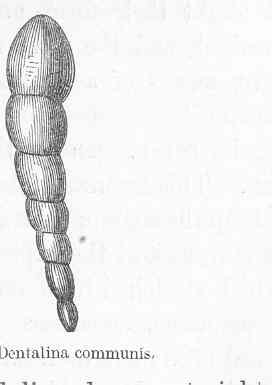
Parafusulina is a genus of foraminifera included in the fusulinacean family Schwagerinidae that were extant during the Permian.

The Rotaliida are an order of Foraminifera, characterized by multilocular tests (shells) composed of bilamellar perforate hyaline lamellar calcite that may be optically radial or granular.
Carterina is a genus in the family Trochamminidae, composing its own subfamily Carterininae. The genus is described from specimens gathered during the Challenger expedition's circumnavigation of the Earth from 1872-1876.
Hantkeninoidea is a superfamily of foraminifera with planispiral or enrolled biserial tests, found in marine sediments of Paleocene to Miocene age, in which chambers vary from globular to elongate and the primary aperture is equatorial in position. It contains one family, the Hantkeninidae.

Globigerinoidea is a superfamily of free-living, calcareous, planktonic foraminiferal protists that have lived in the open ocean since the Eocene. It is part of the suborder Globigerinina.

Lagenida is an order of benthic foraminiferal protists in which the tests (shells) are monolamellar, with walls composed of optically and ultra-structurally radiate calcite, with the crystallographic c-axes perpendicular to the surface. Lagenids first appear in the Upper Silurian and continue to the Recent. They are currently divided into two superfamilies, the older Robuloidacea which range from the Upper Silurian to the Lower Cretaceous (Albian) and the younger Nodosariacea, ranging from the Permian to Recent.
Nodosariacea is one of two superfamilies making up the foraminiferal order Lagenida. The other being the Robuloidacea. Of these two Nodosariacea is the more advanced, as well as being the younger.
Involutinida is an order of foraminifera included in the Spirillinata found in the fossil record from the early Permian to early Late Cretaceous (Cenomanian).
The Rzehakinidae is a family of Lower Cretaceous to recent formaminifera that resemble the calcareous imperforate Miliolidae but which are constructed of finely agglutinated material that veneers an organic base. Tests are with two, or less commonly three, chambers per whorl, which are commonly added in various planes. In form they are generally ovoid.

Cibicides is a genus of cosmopolitan benthic foraminifera known from at least as far back as the Paleocene that extends down to the present.
Discorbis is a genus of benthic Foraminifera, that made its first appearance during the Eocene. Its present distribution is cosmopolitan.
Neoconorbina is a genus of recent (Holocene) discorbacean foraminifers related to Rosalina with a low conical trochoidal test, circular in outline. The conical side is the spiral side, on which all three whorls are visible, the final chamber taking up most of the periphery. The umbilical side is flat to concave. exposing only the three to four chambers of the final whorl around an open umbilicus. Chambers on the umbilical side have triangular to platelike umbilical extensions as with other rasalinids. The wall of is calcite, finely and densely perforate on the spiral side, more coarsely perforate on the umbilical side; surface smooth; aperture at the umbilical margin of the chamber, beneath the platelike extension, or folium.
The Globoroatioidea constitutes a superfamily of Cenozoic plantonic foraminifera. It is part of the suborder Globigerinina. Globoroatioidea have trochospiral tests with rounded to carinate peripheries, the walls of which are of finely lamellar, perforate, of optically radial calcite, with an inner organic lining. The surface of these tests is smooth, lacking spines, but may be covered with pustules or pitted, and may have one or more large pores at the center. There is a single primary aperture that may be bordered by an imperforate lip, as well as possible supplementary apertures.
Sigmoilina is a miliolid genus, referring to the foraminiferal order Miliolida, characterized by an assymmetricall biconvex test formed by strongly overlapping chambers, one-half coil in length, that form a sigmoid (S-shaped) curve in cross section. The strongly overlapping chambers obliterate earlier ones from view resulting in the compressed biloculine appearance, differing from the squat, depressed biloculine form of Pyrgo and Biloculina. The test, as for all Miliolida, is porcelaneous and imperphorate, the terminal aperture, with tooth, the only point of egress and ingress for the animal.
Sigmoilinopsis is a genus of miliolid Foraminifera, with an ovate test, chambers one-half coil in length, arranged in rapidly changing planes in the early stage resulting in two spiralling series that appear sigmoid in section, gradually becoming planispiral in the adult. Walls are thick, porcelaneous but enclosing a large quantity of agglutinated quartz particles, sponge spicules, and shell fragments; the aperture terminal, rounded, with a small tooth.

Hauerinidae is a large and diverse family of miliolid forams that includes genera distributed among various subfamilies in the Treatise as well as genera named and described since.
Hemigordiopsidae is a miliolid family included in the Cornuspiracea that has a range extending from the Early Carboniferous (Visean) to the present.
Cornuspiracea comprise a superfamily of miliolid forams in which the test may be free or attached, planispiral or trochospiral, evolute or involute, spreading or discoidal. The proloculus, or initial chamber, is followed by undivided spiral passage or enrolled tubular chamber, later may be irregularly coiled, unicoiled, or show zigzag growth pattern and may be distinctly chambered. The test wall is composed of imperforate porcelaneous calcite, a character of the Miliolida
Alfred R. Loeblich Jr (1914–1994) was an American micropaleontologist. He was married to Helen Niña Tappan Loeblich and the two co-authored a number of important works on the Foraminifera and related organisms.

Spirocyclinidae is a family of foraminifera included in the order Loftusiida.







